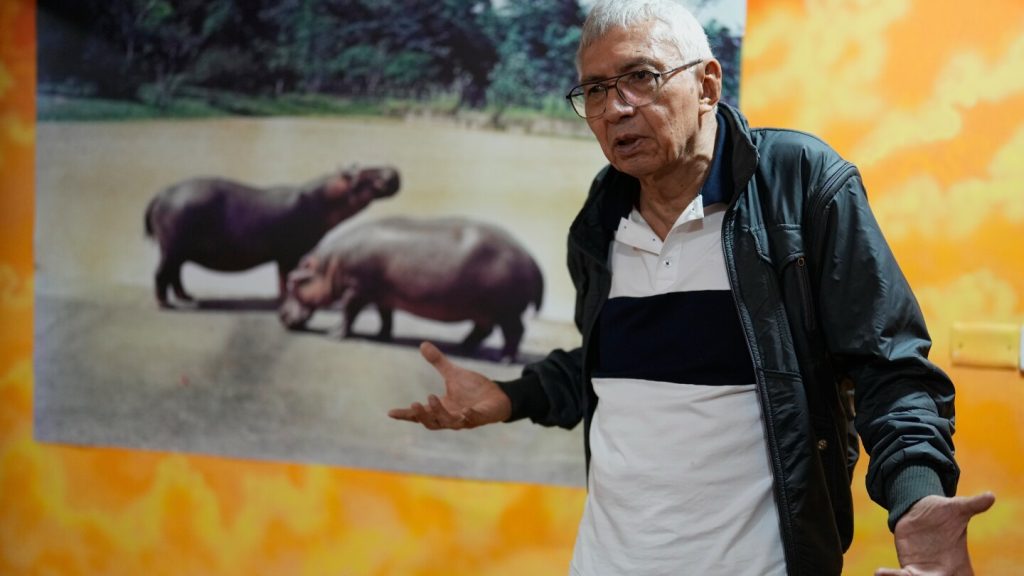Listen to the article
Colombian Photographer Revisits Escobar’s Hippos in New Art Exhibition
In a quiet corner of Bogotá, 75-year-old photographer Édgar Jiménez stands before his portrait “Adam and Eve,” capturing two of the first hippopotamuses brought to Colombia by notorious drug lord Pablo Escobar in the 1980s. The photograph, taken at a precarious distance of just four meters without protection, serves as a stark reminder of his unusual role as Escobar’s personal photographer.
“The hippos were bought from a zoo in the United States that buys and captures animals from Africa,” Jiménez recalls, reflecting on his additional responsibility of maintaining an inventory of the exotic animals housed at Escobar’s lavish Hacienda Nápoles estate in northeastern Colombia.
What began as Escobar’s eccentric collection has morphed into an environmental crisis since the drug kingpin’s death in 1993. The original handful of hippos has exploded into a population exceeding 160, prompting Colombian authorities to declare them an invasive species threatening local ecosystems and communities.
Jiménez’s photographs have found a new audience as part of “Microdoses to Tame the Inner Hippopotamus,” an exhibition featuring 20 artists offering political critiques of what Escobar’s hippos have come to represent in Colombian society. The showcase, which opened Thursday at Casa Échele Cabeza, brings together diverse mediums including oil paintings, graffiti, photography, and even psychoactive mushrooms cultivated in hippo dung.
Exhibition curator Santiago Rueda explains that the show avoids moralizing but instead invites visitors to consider the paradoxical symbolism of these creatures. “It’s not just Escobar, it’s the narco-madness, the excess, the luxury,” Rueda said, noting that narco-aesthetics are resurging not only in Colombia but globally.
Among the exhibition’s standout pieces is Carlos Castro’s tapestry “The Great Narco Ark,” depicting Escobar alongside wild animals descending two by two from a military aircraft—a provocative reimagining of Noah’s Ark that comments on the drug trade’s environmental and social impacts.
Artist Manuel Barón contributes a satirical wanted poster offering a $264,000 reward for the capture of a hippo nicknamed “El Gordo” (The Fat One). “It’s a parody of the drug cartels of the era… from the time when they were searching for Pablo Escobar and all the drug traffickers,” Barón explained, drawing parallels between the hunt for escaped hippos and the manhunt for cartel leaders.
Perhaps the most conceptually complex work comes from artist Camilo Restrepo, who discovered that hallucinogenic mushrooms could be cultivated directly in hippo dung. His installation highlights a poignant irony in Colombia’s complicated relationship with drugs and Escobar’s legacy.
“It’s very contradictory that, due to the failure of the war on drugs, so much money accumulates in the hands of drug traffickers that they can bring in an entire zoo, and then the hippos remain living in Colombia,” Restrepo observed. He noted the philosophical contrast between cocaine, which “elevates the ego,” and the mushrooms growing from hippo waste that “dissolve the ego.”
The exhibition is hosted by Casa Échele Cabeza, a project focused on drug regulation and harm reduction run by the nonprofit organization Acción Técnica Social. The venue’s mission aligns with the exhibition’s exploration of Colombia’s complex relationship with narcoculture and its lasting ecological impacts.
Colombia’s hippo dilemma represents one of the most visible and enduring environmental legacies of the country’s drug trafficking era. With the population continuing to grow, environmental authorities face mounting challenges in managing these dangerous yet symbolically significant animals.
For Jiménez, whose career took an unexpected turn through his association with Escobar, the exhibition offers a rare opportunity to contextualize his documentary work within broader cultural and environmental conversations, transforming images initially taken for inventory purposes into artifacts of historical and artistic significance.
Fact Checker
Verify the accuracy of this article using The Disinformation Commission analysis and real-time sources.




10 Comments
It’s remarkable how these hippos, once symbols of Escobar’s opulence, are now inspiring creative works that shed light on the country’s struggles with the drug trade and its aftermath.
Art can be a powerful medium for processing difficult histories and sparking important conversations. I’m curious to see how the exhibit explores this complex legacy.
It’s fascinating to see how these hippos, once confined to Escobar’s estate, have now become a symbol of the country’s resilience and the ability of nature to reclaim its space.
The photographer’s intimate access to Escobar’s world adds an intriguing layer of authenticity to the artistic interpretations of this legacy.
As an environmental crisis, the proliferation of Escobar’s hippos is a sobering reminder of the long-term consequences of unchecked excess. I’m glad to see the issue being addressed through this artistic lens.
The exhibition sounds like a powerful exploration of the complex intersection of art, history, and environmental stewardship. I look forward to learning more about the artists’ perspectives.
Fascinating to see how artists are using Escobar’s hippos as a canvas to explore Colombia’s complex history. These creatures have become a symbol of the drug lord’s excess and their environmental impact.
The exhibit sounds like a thought-provoking way to reflect on this chapter of Colombia’s past and its lasting consequences.
The photographer’s role as Escobar’s personal photographer adds an intriguing layer to this story. I wonder how he grapples with that part of his past through his current artistic practice.
It’s a testament to the resilience of the human spirit that these hippos, once symbols of oppression, are now being reclaimed and reinterpreted by Colombian artists.